I’ve wanted to make bi-bim-bap at home forever but have always been put off by the amount of work involved. All that chopping, individually cooking everything then assembling the dish seemed monstrously time-consuming and a bit annoying. The bi-bim-baps I’ve had at Korean restaurants are all served in one of those really hot stone pots (dolsot). Often you just crack a raw egg over the dish, mix all the lovely ingredients together and enjoy. The egg cooks perfectly in the hot pot and the rice at the bottom forms this marvelous toasted crust of which I’m particularly fond. Delicious!
I remember as a kid every now and then my mother would burn her rice and get super upset about it. What to her was a disaster to me was a treat because I loved eating the slightly burned and smoky crust. Anytime I eat bi-bim-bap I feel that there is somehow a bit of Brazil in the dish.
I regard bi-bim-bap as a version of paella or pilaf. All of them are rice dishes mixed together with other ingredients. Here are some other recipes for it: here, here and here.
My dish calls for what to me is a novel ingredient, fern brakes. I found these dried and rehydrated at my local Korean market. I bought both types but since they need to soak overnight, I used the rehydrated ones. They have a lovely tea-like aroma and mild flavor, somewhat like subtle fiddlehead ferns.
To make this vegan, simply leave off the eggs.
vegetarian bi-bim-bap
1½ cups Thai Jasmine rice
3 small zucchinis – julienned with a bit of salt sprinkled over
2 medium carrots – julienned
1 cup broccoli florets
2 bunch spinach
3 eggs
½ red bell pepper – julienned
½ orange bell pepper – julienned
1 container brown beech mushroom
1 cup of soy bean sprouts (nato sprouts)
1 cup fern brakes
1lb firm tofu cubed
8 cloves garlic minced/smashed
2 heaping tbsp Gochujang hot pepper paste
3 tbsp rice vinegar
1 tsp sugar
1 tbsp soy sauce
olive oil
toasted sesame seed oil
sea salt
To make the rice:
Add 1 tbsp olive oil to a saucepan on temperature high. Add rice and give it a good stir. Add 2½ cups of water, stir again. Bring to a boil, stir again. Reduce heat to simmer for about 15 minutes, until water has been absorbed. Remove from heat let it rest, lid on for another 15 minutes.
To prepare veggies:
All veggies must be cooked separately.
Bring a pot of water to a boil. Drop in broccoli florets and cook for a minute or so. Transfer to a bowl.
Drop in spinach and let it blanch for a minute or so, transfer to a colander, allow it to cool down a bit. Squeeze to remove as much water as possible.
Using the same saucepan add soybean sprouts and a dash of salt and cook for 10-12 minutes. Strain and squeeze to remove water.
Add 1 tsp of olive oil to a skillet, 2 cloves of garlic minced and sauté until aromatic. Add bean sprouts and cook for few minutes. Season with one tablespoon of soy sauce and ½ tsp sesame oil. Set aside.
Wipe skillet and return to burner. Add 1 tbsp olive oil, 2 garlic cloves minced and mushrooms. Sauté mushrooms on high heat for a couple of minutes. Sprinkle with some salt, cover the pan and let the mushrooms sweat. Set aside.
Wipe Skillet with a paper towel. Add ½ tsp of olive oil, 1 clove of minced garlic and sauté. Add spinach and cook for another minute, season with 1 tsp of soy sauce. Set aside.
Wipe skillet off again. Add ¼ tsp olive oil. Drain zucchini; add to skillet and sauté for 1 minute. Set aside.
Repeat process, this time with no oil with peppers and carrots.
Return skillet to stove. Add 1 tsp of olive oil, 2 cloves of garlic minced, cook until aromatic. Drop in fern brakes and sauté for a couple of minutes, towards the end add 1 tbsp soy sauce and 1 tsp of sesame oil. Set aside.
To prepare pepper sauce:
Meanwhile, mix rice wine vinegar, 3 cloves of garlic minced and Goshujang pepper paste together. Once all mixed it should have the consistency ketchup. Taste it and adjust flavors if necessary. Look for spice, sweet, umami and sour flavors. The paste will be used as a condiment to the Bibimbap at the table.
To assemble dish:
Add a few drops of sesame oil to a non stick paella pan. Using a paper towel rub oil all over its surface including border. Add cooked rice and press with a spatula, making sure the surface and borders are filled. Cover, bring temperature to high and cook for about 10 minutes. This is where rice develops the smoky, brown, nutty slightly burned crust.
Time to assemble the dish! Place cubed tofu in the center over the toasted rice; arrange mounds of each of the ingredients interchangeably along the border, forming a kind of flower pattern. Cover and let it warm through. Serve with fried egg sunny side up and dollops of Goshujang sauce on top of everything. The flavors are out of this world!
You can serve this dish with banchans, or side dishes, like pickled cucumbers or/and kimchi. I was going to serve both but forgot to bring the kimchi to the table.

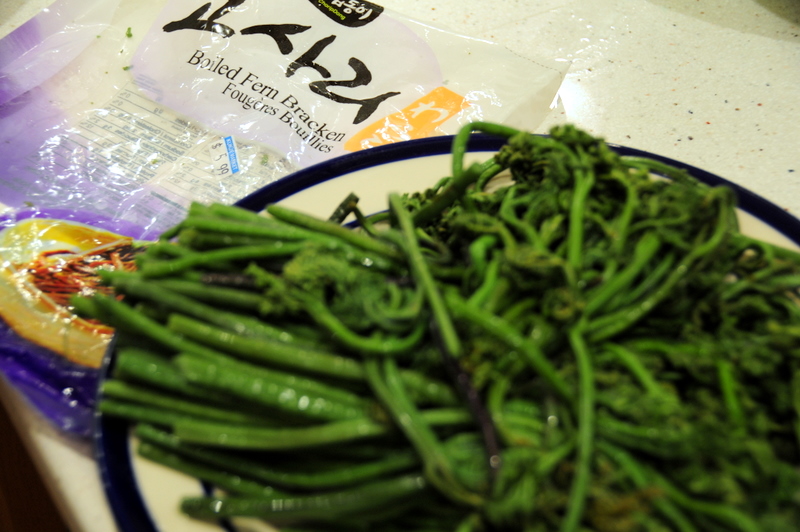
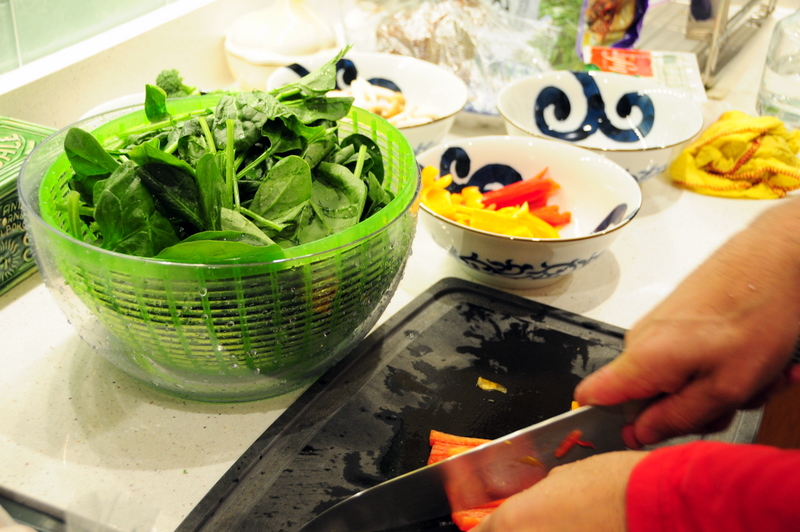
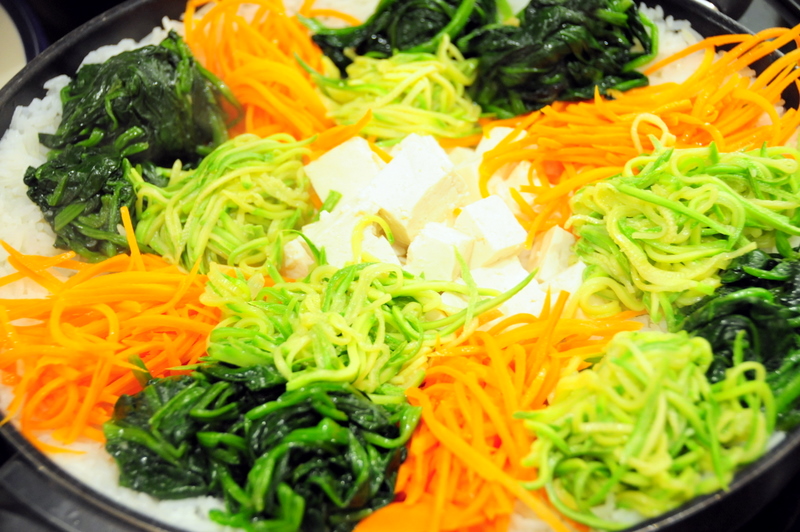
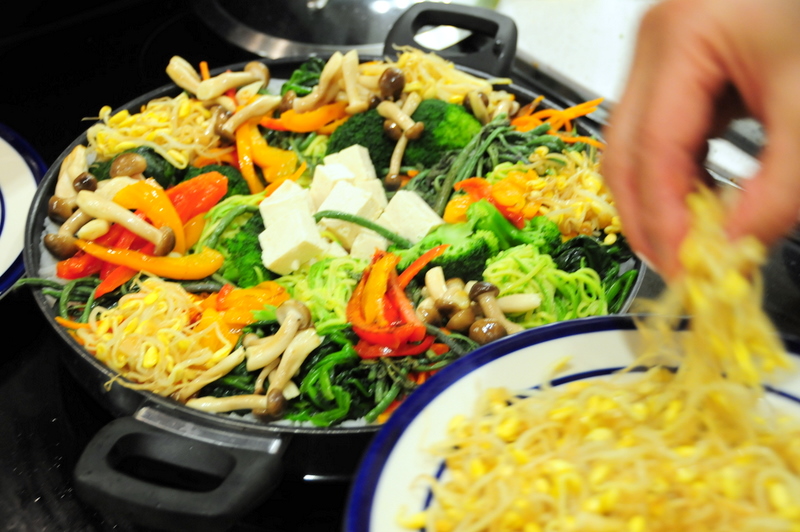
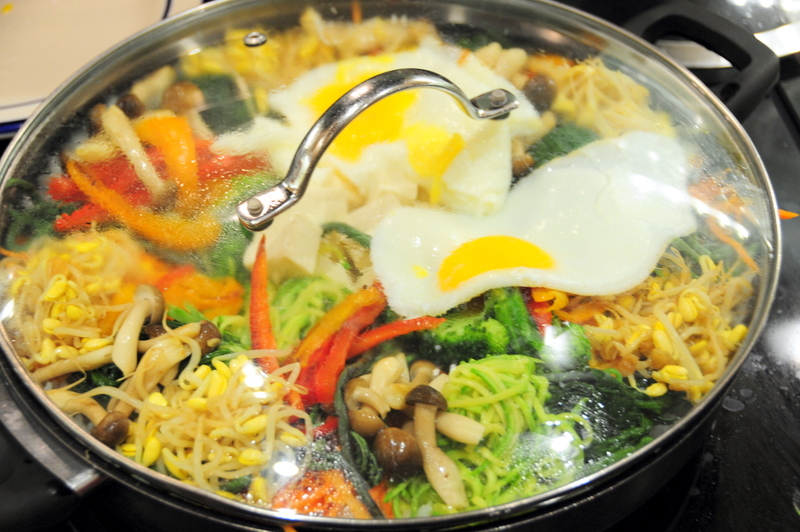
Comments on this entry are closed.
Heguiberto, I have the patience of a puppy, so this will not become a staple in my kitchen, but instead a must-have when I eat out, at least once I find a good restaurant serving bi-bim-bap. Looks awesome. Thanks for initiating my next food quest. Bahn mi and beyond!
Hi Heguiberto,
I always want to try out different combination of foods and you nailed it, your bi-bim-bap vege looks so tasty, thanks for sharing it
What a wonderful vegetarian dish!!!It looks delicious!
Stevie – your vegetarian bibimbap looks great – ours was the meat version on C&L a while back. Here is the vegetarian version of Chiles en Nogada: http://www.ethicurean.com/2007/09/28/stuffed-chilies/. I have also seen versions with a rice and dried fruit stuffing using all the other ingredients, which is really what makes the recipe.
On another track, I love Ottolenghi’s vegetarian style. Truly, this man is a genius in the kitchen! I want to be him when I grow up!